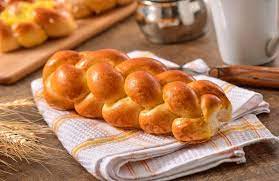Teaching cooking classes, I tell my students that although making beautiful loaf challah may seem daunting, it is very easy to make. Another thing I love to tell my students is that no matter how complicated a 6-strand challah braid is, fresh-baked challah bread is delicious.
Since 20, I have been braiding and baking challah almost every week. I still learn new things all the time. Many tricks, techniques, and tools can help you with your challah-braiding journey. With some practice, you will be able to braid challah in the comfort of your bed.
There are many ways to braid challah. There are four styles of challah braiding: 3-strand, 4-strand and 6-strand. You can also wrap around loaf around a ramekin with honey or any other dip you like. All of these techniques can be used with any challah dough.
Challah Braiding Tips
Weigh the dough. Get a digital scale and weigh every piece of dough to ensure it is the right size. This will ensure the challah bakes evenly and has a uniform appearance.
Press and roll with your heel using the heel of one’s hand Press down with your heel and not your fingertips as you roll each strand. Do not press down on the dough. Instead, press as you roll.
Do not over-roll your strands. Resist any urge to roll and roll your dough into long, thin strips. A thicker loaf will bake better, while a longer, more thin challah will dry quickly.
Braide loosely. As the loaf bakes, the strands will expand. After baking, the challah will not look pulled if you have a loose braid.
How to Make a 3-Strand Challah Loaf
This braiding technique, both simple and classic, is the best. This technique is described below. It involves starting at the middle, braiding one side of the loaf, turning it around and braiding the opposite. This keeps your loaf even. However, you can also start from one end and braid the other side.
- Divide the dough into three equal pieces. Roll each piece into strands of equal length and width. The ends will taper slightly.
- Cross two strands and create an X. Lay the third strand in the middle of the two other strands. The middle should be where all three strands meet.
- Take the strand to the right and lift it. Next, pass it over the middle strand. Next, take the strand to the left and pass it on to the centre strand.
- Continue braiding until you have half of the loaf.
- Rotate the loaf. Loop the strand to the left and place it under the middle strand. Turn the strand to the left and loop it under the centre strand.
- Continue repeating until the second half is braided.
- You can pinch the ends.
- Before baking, brush with egg wash.
How to Make a 3-Strand Challah Round Loaf With Honey Bowl
Inspired by the gorgeous centrepiece challahs New York’s Breads Bakery makes every year for the Jewish New Year, this loaf was created. This bread is made around a ramekin that you can dip in honey. This challah is not only for Rosh Hashanah. You can make it all year. After baking, fill the ramekin with your favourite dips, such as Hummus or Tzatziki. The process is the same as making a three-strand loaf. However, I will repeat the exact instructions. You will need an oven-safe round tray ramekin and cooking spray for this shaping method.
- Use cooking spray to grease the outside of a round glass ramekin. Set aside.
- Divide the dough into 3 pieces. Roll each piece into strands of equal length and width. The ends should be slightly tapered.
- Criss-cross the two strands to create an X. The third strand should be laid down in the middle of the two other strands. The middle should be the intersection of all three strands.
- Take the strand to the right and lift it. Next, pass it over the middle strand. Next, take the strand to the left and pass it on to the centre strand.
- Continue braiding the loaf until you have half of it. Leave the ends unbroken.
- Rotate the loaf. Take the strand to the right and loop it under your centre strand.
- Turn the strand to the left. Loop it under the middle strand. Continue this process until you have braided the first half of the loaf. Leave the ends untied.
- Place the challah on a parchment-lined baking sheet.
- Then, tie the ends of the pieces together to form a circle. You don’t need to make it perfect, but it should be completely closed.
- Before baking, brush with egg wash.
- Once the bread has been removed from the oven, place the ramekin in a bowl and top it with your favourite honey or dip.
How to Make a 4-Strand Challah Loaf
This braid was a gift from a dear friend, a fellow baker. This braid is my favourite. It bakes beautifully, doesn’t require a lot of effort, and creates a nice lift by braiding the strands together. This is my favourite braid, week after week.
- Divide the dough into four equal pieces. Roll each piece into strands of equal length and width. Taper the ends.
- You can pinch the 4 ends and weigh them down. A dough cutter works well, but you could also use a knife.
- Start with the strand to your right. Lift it and cross it over to your left. It should be pulled slightly upwards and not straight down next to the next strand.
- Next, take the strand to your left (and it is now second to your left), and lift it. Cross it over to the right.
- Place the left-side strand on your right hand and gently lay it down in the middle. When braiding, ensure that there is always a path in the middle.
- Lift the second strand to the right and cross it to the left.
- The strand on the right is now laid gently in the middle.
- Continue crossing left to right, then down to the middle, right away, and then down to the middle until the whole loaf is braided.
- You can pinch the ends.
- Before baking, brush with egg wash.
How to Make a 6-Strand Challah Loaf
Although the 6-strand loaf is the most intimidating to look at, if you can master the 4-strand, then the 6 strand is almost identical, with more strands, do not let the extra strands scare you.
- Divide the dough into six equal pieces. Roll each piece into strands of equal length and width. Taper the ends.
- Take 6 strands from the top and pinch them.
- Start with the strand to your right. You can lift it and turn it to your left. It should be pulled slightly upwards and not straight down by the next strand.
- Next, take the strand to your left (and it is now second to your left), and lift it. Cross it over to the right.
- Place the left-side strand on your right hand and gently lay it down the middle. When braiding, ensure that there is always a path in the middle.
- Lift the second strand to the right and cross it to the left.
- The strand on the right is now laid gently in the middle.
- Continue crossing left to right, then down to the middle, right away, and then down to the middle until the whole loaf is braided.
- You can pinch the ends.
- Before baking, brush with egg wash.






More Stories
Chocolate self saucing pudding
Chicken patties recipe
Can you eat a raw potato